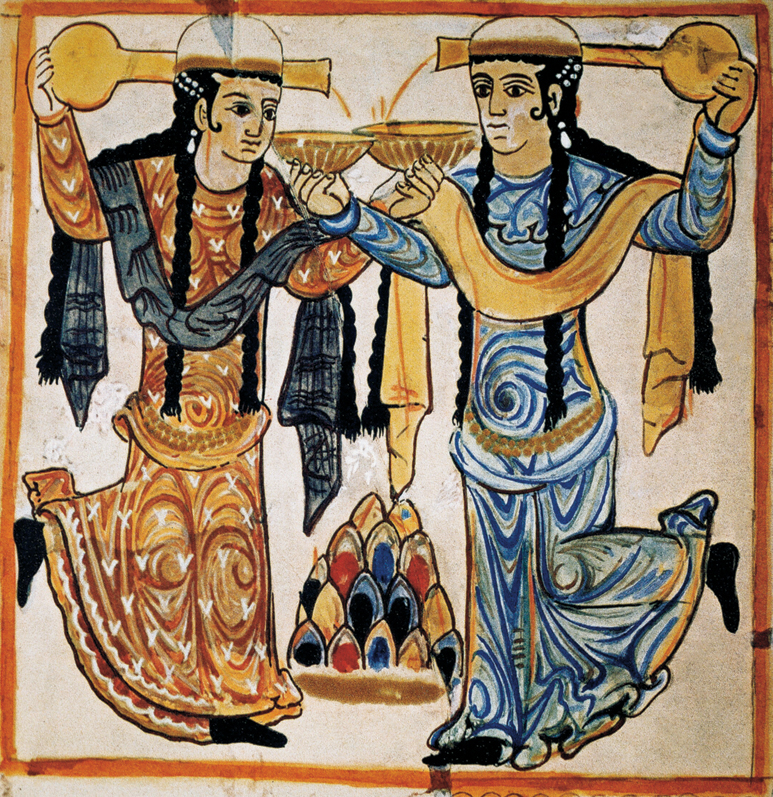A History of World Societies:
Printed Page 249
A History of World Societies Value
Edition: Printed Page 246
Slavery

Slavery had long existed in the ancient Middle East, and the Qur’an accepted slavery much the way the Old and New Testaments did. But the Qur’an prescribes just and humane treatment of slaves, saying that a master should feed and clothe his slaves adequately; give them moderate, not excessive, work; and not punish them severely. The Qur’an also explicitly encourages the freeing of slaves and urges owners whose slaves ask for their freedom to give them the opportunity to buy it. In fact, the freeing of slaves was thought to pave the way to paradise.
Muslim expansion ensured a steady flow of slaves captured in war. The great Muslim commander Musa Ibn Nusayr (640–
Women slaves worked as cooks, cleaners, laundresses, and nursemaids. A few performed as singers, musicians, dancers, and reciters of poetry. Many female slaves also served as concubines. Not only rulers but also high officials and rich merchants owned many concubines. Down the economic ladder, artisans and tradesmen often had a few concubines who assumed domestic as well as sexual duties.
According to tradition, the seclusion of women in a harem protected their virtue (see “Women in Classical Islamic Society”), and when men had the means the harem was secured by eunuch (castrated) guards. The use of eunuch guards seems to have been a practice Muslims adopted from the Byzantines and Persians. Early Muslim law forbade castration, so in the early Islamic period Muslims secured eunuchs from European, African, and Central Asian slave markets. In contrast to China, where only the emperor could have eunuch servants, the well-
Muslims also employed eunuchs as secretaries, tutors, and commercial agents, possibly because eunuchs were said to be more manageable and dependable than men with ordinary desires. Male slaves, eunuchs or not, were also set to work as longshoremen on the docks, as oarsmen on ships, in construction crews, in workshops, and in gold and silver mines.
As already noted, male slaves also fought as soldiers. Any free person could buy a slave, but only a ruler could own military slaves. In the ninth century the rulers of Tunisia formed a special corps of black military slaves, and at the end of that century the Tulunid rulers of Egypt built an army of 24,000 white and 45,000 black slaves. The Fatimid rulers of Egypt (969–
Slavery in the Islamic world differed in at least two fundamental ways from the slavery later practiced in the Americas. First, race had no particular connection to slavery among Muslims, who were as ready to take slaves from Europe as from Africa. Second, slavery in the Islamic world was not the basis for plantation agriculture, as it was in the southern United States, the Caribbean, and Brazil in the eighteenth and nineteenth centuries. True, in the tenth century large numbers of black slaves worked on date plantations in northeastern Arabia. But massive revolts of black slaves called Zanj from East Africa (see “The East African City-States” in Chapter 10), provoked by mercilessly harsh labor conditions in the salt flats and on the sugar and cotton plantations of southwestern Persia, erupted in 869. Gathering momentum, the Zanj captured the rich cities of Ahwaz, Basra, and Wasit and threatened Baghdad. Only the strenuous efforts of the commander of the caliph’s armies, which were composed of Turkish slaves and included naval as well as land forces, halted and gradually crushed the Zanj in 883. The long and destructive Zanj revolt ended the Muslim experiment with plantation agriculture.
Slavery was rarely hereditary in the Muslim world. Most slaves who were taken from non-